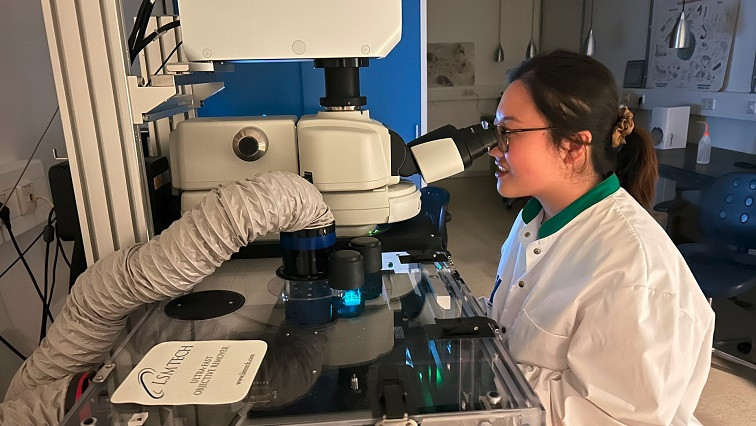Disposable cups, plastic bags and packaging material: plastics exposed to the elements become brittle over time, and start shedding small particles from their surface into nature. These particles can be as tiny as only a few nanometers in size: nanoplastics. You can find them everywhere now: in the sea, in the soil, in the food chain… ‘And in our blood,’ says Wang. ‘Nanoplastics have even been found in human placentas.’
From the blood to the rest of the body
This prompted Wang to think: What happens when those nanoplastics end up in the blood of the embryo? ‘During an earlier study, we discovered that a high concentration of nanoplastics can cause malformations in the heart, eyes, and nervous systems of chicken embryos. But for a more complete understanding of the toxicity of nanoplastics, we first need more information about how they spread from the blood throughout the rest of the body.’ That knowledge will also be informative in nanomedicine, where scientists aim to use nanoplastics (and other nanoparticles) as vehicles for drug-delivery.
Tracking fluorescent nanoparticles in chicken embryos
Wang and her colleagues administered polystyrene nanoparticles directly into the bloodstream of chicken embryos. Wang: ‘Chicken embryos are a widely used model for research on growth and development. In mammals, it’s much more challenging to administer substances or take measurements because their embryos develop inside the mother’s womb.’ Because nanoparticles are so small, it’s impossible to see them using conventional microscopes. Therefore, Wang and her colleagues tagged the nanoparticles with either fluorescence or europium, a rare metal that is not naturally present in the human body.
Nanoplastics enter developing organ tissue
Wang: ‘We found that the nanoplastics can cross blood vessel walls, and that they accumulated to relatively high levels in the heart, liver and kidneys. Some nanoplastics were excreted by the kidneys.’
Interestingly, the researchers also found nanoplastics in the avascular heart cushions: a type of heart tissue without blood vessels. Wang: ‘We believe the nanoplastics might enter the heart through the fenestrate. These are small openings within the developing heart tissue that play a role in the formation and remodeling of the heart’s structure during development.’ These fenestrations are temporary structures that typically close as the heart matures.
No nanomedicines for pregnant women?
‘Now we know how these nanoplastics spread, we can start investigating the health risks,’ says Wang. And the outlook isn’t necessarily good. ‘There is already research linking nanoparticles to a higher risk of heart attacks and strokes. Especially during the developmental stage, nanoparticles could potentially be quite dangerous. Because of our results, we now understand that we shouldn’t administer nanomedicines to pregnant women indiscriminately, as there is a risk that nanoparticles could reach and affect the developing organs of their babies.’
‘I just love microscopes’
Wang started five years ago in this relatively new field. ‘Everyone was asking questions about nanoparticles, but nothing was known. Especially not about the effects of nanoplastics in warm-blooded animals. I started from scratch and kept finding interesting results. That was my drive. I wanted to know: where do these particles go, why are they there, and are they harmful? I believe our research truly contributes to human and animal health.’ But the real reason? ‘I just love microscopes,’ Wang says with a smile. ‘ Some people say they’re boring, but I could stare through them every day for the rest of my life.’
Read the original article on Leiden University.







